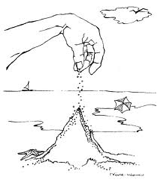|
Earthquakes, Forest Fires, Stars and Brains
Human brain activities that give rise to thinking may be akin to the dynamics of earthquakes, forest fires, the spread of contagious disease, the distribution of galaxies in the universe and the sand in an hourglass.
 Flip an hour glass upside down, and sand running into the bottom of the glass forms a pile that eventually becomes so unstable that one more grain can cause the pile to collapse into an avalanche. When that happens, the base of the sand pile flattens out, another pile begins, and then it too reaches a point where it collapses. Through several avalanches of varying sizes, the sand pile maintains overall stability. It's a process Danish-American scientist Per Bak called "self organized criticality." Flip an hour glass upside down, and sand running into the bottom of the glass forms a pile that eventually becomes so unstable that one more grain can cause the pile to collapse into an avalanche. When that happens, the base of the sand pile flattens out, another pile begins, and then it too reaches a point where it collapses. Through several avalanches of varying sizes, the sand pile maintains overall stability. It's a process Danish-American scientist Per Bak called "self organized criticality."
When he died in 2002, The New York Times described Dr. Bak as an "intellectually pugnacious physicist who sought to understand how complexity arises in the world," and how the simple particles that make up the universe could be transformed into the extraordinarily intricate order found in nature. A story by Jennifer Ouellette in Quanta Magazine and reprinted in the Scientific American, explains that Dr. Bak found an answer in phase transition, the process in which materials pass from one state to another. The phase change of water to steam, for example, depends only on temperature and air pressure. Ouellette explains Dr. Bak proposed phase change in which local interactions among many elements of a complex system could spontaneously self organize to reach the tipping point he called criticality. In a 1987 paper in Physical Review Letters, Dr. Bak and coauthors described self organized criticality as the underlying mechanism behind the flow of rivers, the luminosity of stars, and what happens in sand piles and other dynamical systems. His book How Nature Works expands on the idea.
Neuroscientists didn't immediately embrace Dr. Bak's idea on brain function when he proposed it 15 years ago. In the last decade, however, EEG recordings of the interactions among individual brain neurons, large scale studies comparing computer model predictions and fMRI images, and examinations of slides of cortical tissue, have produced evidence that the brain exhibits properties of criticality. Neurophysiologist Dante Chialvo, from the University of California at Los Angeles, is among the renowned scientists who now think self organized criticality could explain brain activity. The idea is also being explored by national and international research efforts.
 Getting back to the hour glass. Ouellette explains that when the sand pile-a complex system with millions of tiny elements-reaches the critical point, there is no way to predict which next grain will cause the avalanche, how big any avalanche will be, or how many there will be before all the sand is in the bottom of the glass. The things you can predict are that the falling of one extremely tiny grain can have a big impact; and that while overall stability of the system is maintained-there's still a pile-and there will be more small avalanches than big ones, in line with what mathematicians call power laws. Getting back to the hour glass. Ouellette explains that when the sand pile-a complex system with millions of tiny elements-reaches the critical point, there is no way to predict which next grain will cause the avalanche, how big any avalanche will be, or how many there will be before all the sand is in the bottom of the glass. The things you can predict are that the falling of one extremely tiny grain can have a big impact; and that while overall stability of the system is maintained-there's still a pile-and there will be more small avalanches than big ones, in line with what mathematicians call power laws.
The exact moment of transition in a phase change is the critical point when the system is half way between one phase and the next. Each of the tens of billions of neurons in our brains, their connections and their interactions, produce "the emergent process we call thinking," the Quanta article says. It goes on to say that Dr. Bak's idea "implies that most of the time, the brain teeters on the edge of a phase transition, hovering between order and disorder."
Liberating Structures Workshop
May 29-30 - Washington, DC
Register

Smart leaders know that they would greatly increase productivity and innovation if only they could get everyone fully engaged. The challenge is how. Liberating Structures are novel, practical and effective methods to help you accomplish this goal with groups of any size. During this roll-up-your-sleeves immersion workshop, participants will learn and immediately practice 10-12 Liberating Structures while receiving tips on how to implement them in the workplace and traps to avoid. Event flyer (pdf). 1-day, $150. 1 1/2-day, $200. Attendance limited to 100. ebook now available!
Who should attend? Tired of the same conversations with no action? Need to get unstuck? Leaders, designers, consultants, managers, and anyone ready for action will benefit from Liberating Structures! That means you!
Leading Adaptive Change Healthcare Workshop
May 5-7 - Philadelphia, PA
Register
Please join us on May 5-7 in Philadelphia for a new workshop, Leading Adaptive Change, and leave with approaches for engaging your organization to tackle stubborn challenges in patient safety. Too often, patient safety and quality improvement efforts fail because they focus on technical changes-such as introducing new tools and technologies-without addressing the values, beliefs and attitudes of the group involved in the work. This three-day program provides participants with concrete methods and tools for adaptive change.
Remember PlexusCalls!
PlexusCalls
Friday, April 25, 2014- 1-2 PM ET
Mentoring Military Women
Guests: Heather Gunther, Michelle Alexander, and Lisa Kimball
The U.S. Army is making more positions gender neutral, but women are still a minority in the rank and file and an even smaller minority in leadership. The new Women's Mentorship Network (WMN) at Fort Hood, Texas, is designed to cultivate capable, resilient and confident women leaders who will enrich the armed forces with their abilities as new leadership opportunities arise.
Heather Gunther, one of the creators of the new network, is an active duty Army Signal Corps officer assigned to 3d Armored Brigade Combat Team, 1st Cavalry Division at Fort Hood Texas. She was commissioned from West Point in 2002 and has served with the 1st Infantry Division and the 7th Signal Brigade in Tikrit, Iraq and at Mannheim, Germany. Heather holds a B.S. from the United Stated Military Academy, an M.S. in Information Technology, and is currently working on a doctoral thesis on women in the military.
Michelle Alderson, A WMN colleague, is an active duty Medical Service Corps officer assigned to the 3d Armored Brigade Combat Team, 1st Cavalry Division at Fort Hood, Texas. Michelle graduated from West Point in 2009, where she earned her commission and a lifelong passion for lifesaving. Michelle served with the 1st Cavalry Division during a yearlong combat tour to Maysan, Iraq. Her experiences with battlefield trauma and emergency medicine have inspired her to become a physician. Michelle will attend medical school starting this August.
Lisa Kimball, PhD is an entrepreneur with more than 30 years experience as an organizational consultant with business, government and nonprofit organizations. As CEO of Metasystems Design Group and Executive Producer of Group Jazz, she supported the efforts of teams, task forces, communities and organizations and helps them leverage the power of technology and social media. Before coming to Fort Hood, Major Gunther had been at the Army's general staff college at Fort Leavenworth. While there, she participated in a 2011 leadership development program with Ori Brafman, the author of The Starfish and the Spider. a book about successful organizations that are decentralized and adaptive. She also met Lisa Kimball, and later conferred with Lisa and Ori about the WMN. Heather and her colleagues decided to infuse the new venture with some of the processes and practices that had inspired participants in the groups at Fort Leavenworth.
Healthcare PlexusCalls
Wednesday, April 16, 2014- 1-2 PM ET
Clinical Pharmacists as Internal Change Agents
Guest: Rohit Moghe
For many laymen, clinical pharmacists are "the wizards behind the screen," much of their work invisible to the public eye. In hospitals, clinical pharmacists collaborate with physicians and other healthcare professionals, while working directly with patients. They not only round on various medical teams, but also provide various consultative services. In outpatient settings such as clinics and infusion centers (chemotherapy, biologics), patients often interact with the clinical pharmacist, who may fill a role in chronic disease management similar to nurse practitioners and physician assistants, helping the patient manage his or her condition. With their medication expertise, they are crucial in promoting safe, rational, evidence-based use of medications, impact medication adherence, and provide insight into quality of care and outcomes through research.

Rohit Moghe, PharmD, MPH, is an advanced practice pharmacist and a certified diabetes educator with a passion for public health. He received his bachelor's in biology at Penn State University, Doctor of Pharmacy from University of Illinois-Chicago, and Masters of Science in Public Health from Thomas Jefferson University. He currently works at Thomas Jefferson University Hospital, a large, urban teaching university hospital. He is involved in various activities throughout the organization including patient care, patient education, staff development, research, medication use policy, drug therapy surveillance, population management, and health care technology.
Audio from all PlexusCall series is available by searching the iTunes store for plexuscalls. Or, visit plexusinstitute.org under Resources/Call Series.
|